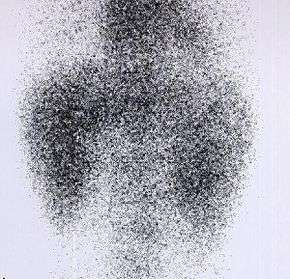DMSA scan
| DMSA scan | |
|---|---|
| Medical diagnostics | |
 Decreased Tc99m-DMSA uptake in both kidneys, suggestive of renal failure. | |
| ICD-10-PCS | CT131ZZ |
| MeSH | D019783 |
| OPS-301 code | 3-706.0 |
| eMedicine | 2165400 |
| LOINC | 39854-5 |
A DMSA scan is a radionuclide scan that uses dimercaptosuccinic acid (DMSA) in assessing renal morphology, structure and function. Radioactive technetium-99m is combined with DMSA and injected into a patient, followed by imaging with a gamma camera.[1] A DMSA scan is usually static, other radiotracers are usually used with dynamic imaging to assess renal function.[2]
The major clinical indications for this investigation are the detection and/or evaluation of a renal scar, the small or absent kidney (renal agenesis), an occult duplex system, certain renal masses, systemic hypertension or suspected vasculitis.[3] It is sometimes used as a test for the diagnosis of acute pyelonephritis.[4] However, the sensitivity of DMSA scan for acute pyelonephritis may be as low as 46%.[5]
References
- ↑ "Renal Cortical Scintigraphy (DMSA scan) Clinical Guidelines" (PDF). BNMS. 2011. Retrieved 11 June 2017.
- ↑ Fogelman, Ignac; Clarke, Susan; Cook, Gary; Gnanasegaran, Gopinath (2014). Atlas of Clinical Nuclear Medicine, Third Edition. CRC Press. p. 443. ISBN 9781841847528.
- ↑ Gordon I (March 1987). "Indications for 99mtechnetium dimercapto-succinic acid scan in children". The Journal of Urology. 137 (3): 464–7. PMID 3029435.
- ↑ Goldraich NP, Goldraich IH (April 1995). "Update on dimercaptosuccinic acid renal scanning in children with urinary tract infection". Pediatric Nephrology. 9 (2): 221–6, discussion 227. doi:10.1007/bf00860755. PMID 7794724.
- ↑ Bailey RR, Lynn KL, Robson RA, Smith AH, Maling TMJ, Turner JG. "DMSA renal scans in adults with acute pyelonephritis". Clinical Nephrology. 46 (2): 99–104. PMID 8869786.